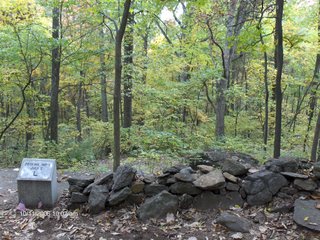Little Round Top


Little Round Top is a small but distinct hill that was on the far southern part of the line between the Union and the Confederates at Gettysburg. The panoramic picture shows the view from the top of Little Round Top down to Devil's Den, the rocky area at the upper left. Though the Federals held the high ground at Little Round Top, the Den, held by the Confederates, also had plenty of shelter in the large rocks there. The two sides spent a lot of time sniping at each other. The sites are 500 yards apart, but both sides had rifles that were effective out to 1000 yards, so the sniping was a lethal problem.
The Confederates launched many attacks on Little Round Top. It was the absolute left flank of the whole Federal line at Gettysburg, so a succesful Confederate attack could have thrown the Federals' entire battle order into disarray. Perhaps the Rebels' strongest attack was aimed at the far left flank of the Federal line on the hill. A strong regiment of Alabamans made repeat attacks on the 20th Maine, which held the position under the command of Colonel Joshua Chamberlain. Chamberlain, a mild mannered schoolteacher from rural Maine, was told to hold the line at all costs...and he did. But eventually his troops ran out of ammunition, and the Alabamans were still coming. So Chamberlain did the unexpected...with ammo gone, he charged down the hill into the trees you see in the picture, routed the Alabamans, and held the line for the Union. Imagine the scene. Thousands of good ol' boys are coming after your ass, hollering
the rebel yell; shot and musket balls are whizzing all around you; you're exhausted; it's hot; you haven't had a bath in a week. So...you charge!! Massive cojones, I reckon! And it worked. And for the Alabamans to repeatedly charge up the hill into the Federal guns, lotta guts there too. Pretty amazing.
Chamberlain was later promoted to general, and led his troops through the rest of the war. He was seriously wounded, but survived the conflict, went back to Maine, and became, I believe, the governor. Or a senator. He lived another 51 years after Gettysburg, until 1914; when he finally died well into his 80s. His Civil War wounds were listed as the cause.

0 Comments:
Post a Comment
<< Home